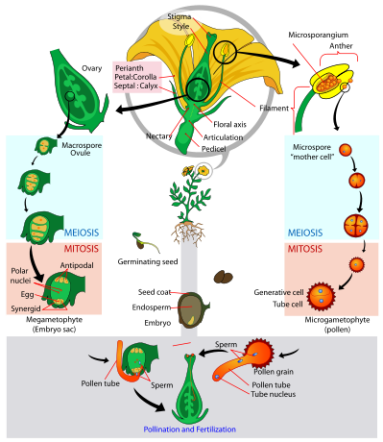Reproduction
Achillea millefolium is a dioecious flowering plant that undergoes sexual reproduction through an alternation of generations as its primary means of reproduction. In fact, the Common Yarrow undergoes the same life cycle as nearly all other dioecious flowering plants. The term dioecious, of course, means that both the male and female parts are necessary for reproduction and are found on separate plants.

To begin, the ovary of the female plant, which is located in the interior of the flower, contains the flower’s ovules on its exterior. The ovules undergo meiosis of the macrospore followed by mitosis to create a megametophyte (or embryo sac) as seen on the left side of the diagram. In contrast, in the male plant there are numerous microsporangia that undergo meiosis and then mitosis, creating a microgametophyte, or pollen. This step is seen on the right side of the diagram. Next, comes the most pivotal step in the life cycle, pollination. Pollination occurs when animals such as bees, butterflies, and birds transfer the pollen (microgametophyte) from the male plant to the female plant. Learn more about specific species that act as pollinators to Yarrow, such as The Ruby-Throated Hummingbird, The Rusty-patched bumble bee, The Western Honey Bee, and The Monarch Butterfly.
Upon arrival, the pollen travels down the pollen tube and finally reaches the embryo. At last fertilization and germination takes place, producing a diploid zygote that grows into Yarrow. In addition, the ovary now will develop into fruit and the ovule will develop into seed. This brings us back to the start of Achillea millefolium’s life cycle!
Other angiosperms that undergo similar alternation of generation reproductive cycles include Trillium, and the Poppy. Discover more about these fascinating organisms too!
Back to Nutrition
To discover the various medical uses and intimate relationships between Achillea millefolium and other organisms, continue to Interactions.
